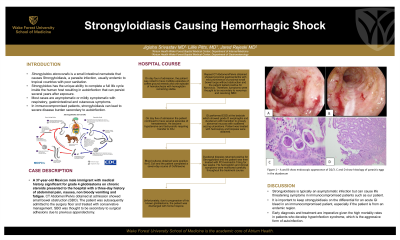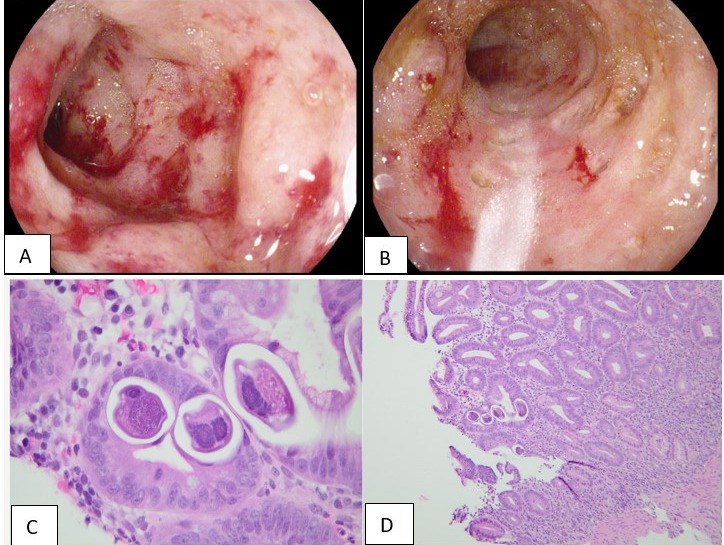Monday Poster Session
Category: GI Bleeding
P2106 - Strongyloidiasis Causing Hemorrhagic Shock
Monday, October 23, 2023
10:30 AM - 4:15 PM PT
Location: Exhibit Hall

Has Audio

Jigisha Srivastav, MD
Wake Forest Baptist Health
Winston-Salem, NC
Presenting Author(s)
Jigisha Srivastav, MD, Lillie Pitts, MD, Jared Rejeski, MD
Wake Forest Baptist Health, Winston-Salem, NC
Introduction: Strongyloides sterocoralis is a small nematode that causes strongyloidiasis, an infection typically endemic in tropical climates with poor sanitation. Strongyloides has the unique ability to complete a full life cycle inside the human host resulting in autoinfection that can persist several years after exposure. Most cases are asymptomatic or mildly symptomatic with respiratory, gastrointestinal, and cutaneous symptoms. However, in immunocompromised patients, strongyloidiasis can lead to severe disease burden secondary to autoinfection. Below we present an unusual case of duodenal hemorrhage secondary to strongyloidiasis.
Case Description/Methods: A 37-year-old Mexican male immigrant with medical history significant for grade 4 glioblastoma on chronic steroids presented to the hospital with a three-day history of abdominal pain, nausea, non-bloody emesis and fatigue. CT abdomen/pelvis on admission showed a small bowel obstruction (SBO) and the patient was treated with conservative management. On day four of admission, the patient was noted to have multiple episodes of coffee ground emesis and one episode of hematochezia but stable hemoglobin. Repeat CT abdomen/pelvis obtained showed proximal gastroenteritis with mild prominence of proximal small bowel loops without obstruction and the patient tested positive for norovirus. Therefore, symptoms were attributed to norovirus and resolving SBO. On hospital day five, the patient had several episodes of hematemesis with hypotension and tachycardia requiring ICU transfer. EGD revealed LA grade D esophagitis and nodular, erythematous mucosa in D2/3 with scattered oozing ulcerations. Biopsies were obtained and Hemospray was applied. Duodenal biopsies returned positive for Strongyloides and the patient was then treated with Ivermectin 15mg for two weeks. His hemoglobin and clinical symptoms were monitored carefully throughout the treatment course. Unfortunately, due to progression of his known glioblastoma, the patient was discharged with home hospice.
Discussion: Strongyloidiasis is typically an asymptomatic infection but can cause life threatening symptoms in immunocompromised patients. It is important to keep strongyloidiasis on the differential for an acute GI bleed in an immunocompromised patient, especially if the patient is from an endemic region. Early diagnosis and treatment are imperative given the high mortality rates in patients who develop hyperinfection syndrome.

Disclosures:
Jigisha Srivastav, MD, Lillie Pitts, MD, Jared Rejeski, MD. P2106 - Strongyloidiasis Causing Hemorrhagic Shock, ACG 2023 Annual Scientific Meeting Abstracts. Vancouver, BC, Canada: American College of Gastroenterology.
Wake Forest Baptist Health, Winston-Salem, NC
Introduction: Strongyloides sterocoralis is a small nematode that causes strongyloidiasis, an infection typically endemic in tropical climates with poor sanitation. Strongyloides has the unique ability to complete a full life cycle inside the human host resulting in autoinfection that can persist several years after exposure. Most cases are asymptomatic or mildly symptomatic with respiratory, gastrointestinal, and cutaneous symptoms. However, in immunocompromised patients, strongyloidiasis can lead to severe disease burden secondary to autoinfection. Below we present an unusual case of duodenal hemorrhage secondary to strongyloidiasis.
Case Description/Methods: A 37-year-old Mexican male immigrant with medical history significant for grade 4 glioblastoma on chronic steroids presented to the hospital with a three-day history of abdominal pain, nausea, non-bloody emesis and fatigue. CT abdomen/pelvis on admission showed a small bowel obstruction (SBO) and the patient was treated with conservative management. On day four of admission, the patient was noted to have multiple episodes of coffee ground emesis and one episode of hematochezia but stable hemoglobin. Repeat CT abdomen/pelvis obtained showed proximal gastroenteritis with mild prominence of proximal small bowel loops without obstruction and the patient tested positive for norovirus. Therefore, symptoms were attributed to norovirus and resolving SBO. On hospital day five, the patient had several episodes of hematemesis with hypotension and tachycardia requiring ICU transfer. EGD revealed LA grade D esophagitis and nodular, erythematous mucosa in D2/3 with scattered oozing ulcerations. Biopsies were obtained and Hemospray was applied. Duodenal biopsies returned positive for Strongyloides and the patient was then treated with Ivermectin 15mg for two weeks. His hemoglobin and clinical symptoms were monitored carefully throughout the treatment course. Unfortunately, due to progression of his known glioblastoma, the patient was discharged with home hospice.
Discussion: Strongyloidiasis is typically an asymptomatic infection but can cause life threatening symptoms in immunocompromised patients. It is important to keep strongyloidiasis on the differential for an acute GI bleed in an immunocompromised patient, especially if the patient is from an endemic region. Early diagnosis and treatment are imperative given the high mortality rates in patients who develop hyperinfection syndrome.

Figure: Figure 1 – A and B show endoscopic appearance of D2/3 and C and D show histology of parasitic organism present in duodenal glands
Disclosures:
Jigisha Srivastav indicated no relevant financial relationships.
Lillie Pitts indicated no relevant financial relationships.
Jared Rejeski indicated no relevant financial relationships.
Jigisha Srivastav, MD, Lillie Pitts, MD, Jared Rejeski, MD. P2106 - Strongyloidiasis Causing Hemorrhagic Shock, ACG 2023 Annual Scientific Meeting Abstracts. Vancouver, BC, Canada: American College of Gastroenterology.
